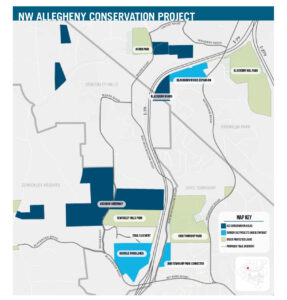January 9, 2023
For Immediate Release
Allegheny County, PA – Local conservation nonprofit Allegheny Land Trust (ALT) conserved another 120.5 acres at the end of December 2022 over eight projects across Allegheny County.
“With development and infrastructure expansion continuing to consume approximately 2,000 acres of green space in the County each year, conserving these lands was a great way to end the year,” ALT President & CEO Chris Beichner said. “From the smallest conserved parcel to the largest, each project will create lasting benefits for each community’s air and water quality, wildlife habitat, biodiversity and recreation and environmental education opportunities.”
The recently-protected lands were a combination of market rate purchases, conservation easements and donated properties, and are located in Baldwin, Millvale and Wilkinsburg Boroughs, and Indiana, Moon, Reserve and Shaler Townships.
“Community support is crucial to the success of our land conservation efforts,” Beichner said. “These communities rallied behind these projects and built tremendous support to help save these green spaces.”
Among the conserved lands is the Reserve/Shaler project, which generated support from surrounding municipalities, local businesses, students in a Shaler Area High School sustainability class and hundreds of individuals. The project involved a partnership between the previous landowner, a new farmer and ALT. Its permanent protection enables the new farmer to farm another portion of the parcel and adds 45 acres to ALT’s conservation successes in the Girty’s Run Watershed.
Along the Montour Trail sits another newly-conserved land. The 14.75-acre green space builds upon the partnered efforts of ALT, Hollow Oak Land Trust (HOLT) and the Montour Trail Council. Now that it is acquired, ALT will transfer the land to HOLT for permanent protection to add to its 320-acre Montour Woods along the Montour Trail.
As part of ALT & Grow Pittsburgh’s Three Rivers Agricultural Land Initiative (TRALI), a 0.14 acre addition to the Garden Dreams site will allow Grow Pittsburgh and gardeners to expand their urban agriculture operations and community outreach at the site.
“The addition of this corner lot is key to the next phase of our Garden Dreams plans,” said Grow Pittsburgh Director of Development and Communications Ryan Walsh. “In a more immediate sense, it also allows us to care for this corner lot. We’re excited to transform it from what has been an unsightly mess of weeds and debris to a neighborhood green space.”
In all of 2022, ALT conserved 290 acres of green space across multiple projects. Every resident of Allegheny County now lives within eight miles of an ALT conservation area.
“While this year’s additions are reason to celebrate our successes, we are already ramping up for several more projects this year,” Beichner said. “We are excited to continue working with communities across our region on protecting close-to-home green spaces.”
ABOUT ALLEGHENY LAND TRUST
Founded as a 501(c)(3) nonprofit in 1993 in response to the rapidly declining amount of green space in Allegheny County, Allegheny Land Trust has protected more than 3,700 acres to preserve our region’s unique natural beauty, provide accessible outdoor recreational opportunities, improve water quality, sustain biodiversity, and enhance the overall quality of life for all. ALT’s strategic priorities are in land protection, land stewardship, community conservation, and environmental education. More information: www.alleghenylandtrust.org.

